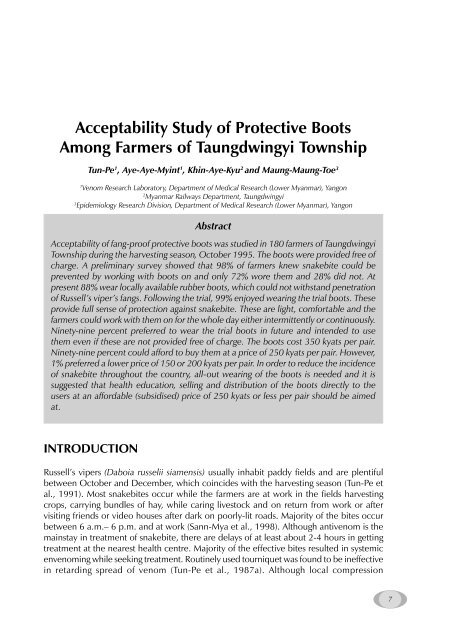Management of Snakebite and Research Management of Snakebite ...
Management of Snakebite and Research Management of Snakebite ...
Management of Snakebite and Research Management of Snakebite ...
Create successful ePaper yourself
Turn your PDF publications into a flip-book with our unique Google optimized e-Paper software.
Acceptability Study <strong>of</strong> Protective Boots<br />
Among Farmers <strong>of</strong> Taungdwingyi Township<br />
Tun-Pe 1 , Aye-Aye-Myint 1 , Khin-Aye-Kyu 2 <strong>and</strong> Maung-Maung-Toe 3<br />
1 Venom <strong>Research</strong> Laboratory, Department <strong>of</strong> Medical <strong>Research</strong> (Lower Myanmar), Yangon<br />
2 Myanmar Railways Department, Taungdwingyi<br />
3 Epidemiology <strong>Research</strong> Division, Department <strong>of</strong> Medical <strong>Research</strong> (Lower Myanmar), Yangon<br />
INTRODUCTION<br />
Abstract<br />
Acceptability <strong>of</strong> fang-pro<strong>of</strong> protective boots was studied in 180 farmers <strong>of</strong> Taungdwingyi<br />
Township during the harvesting season, October 1995. The boots were provided free <strong>of</strong><br />
charge. A preliminary survey showed that 98% <strong>of</strong> farmers knew snakebite could be<br />
prevented by working with boots on <strong>and</strong> only 72% wore them <strong>and</strong> 28% did not. At<br />
present 88% wear locally available rubber boots, which could not withst<strong>and</strong> penetration<br />
<strong>of</strong> Russell’s viper’s fangs. Following the trial, 99% enjoyed wearing the trial boots. These<br />
provide full sense <strong>of</strong> protection against snakebite. These are light, comfortable <strong>and</strong> the<br />
farmers could work with them on for the whole day either intermittently or continuously.<br />
Ninety-nine percent preferred to wear the trial boots in future <strong>and</strong> intended to use<br />
them even if these are not provided free <strong>of</strong> charge. The boots cost 350 kyats per pair.<br />
Ninety-nine percent could afford to buy them at a price <strong>of</strong> 250 kyats per pair. However,<br />
1% preferred a lower price <strong>of</strong> 150 or 200 kyats per pair. In order to reduce the incidence<br />
<strong>of</strong> snakebite throughout the country, all-out wearing <strong>of</strong> the boots is needed <strong>and</strong> it is<br />
suggested that health education, selling <strong>and</strong> distribution <strong>of</strong> the boots directly to the<br />
users at an affordable (subsidised) price <strong>of</strong> 250 kyats or less per pair should be aimed<br />
at.<br />
Russell’s vipers (Daboia russelii siamensis) usually inhabit paddy fields <strong>and</strong> are plentiful<br />
between October <strong>and</strong> December, which coincides with the harvesting season (Tun-Pe et<br />
al., 1991). Most snakebites occur while the farmers are at work in the fields harvesting<br />
crops, carrying bundles <strong>of</strong> hay, while caring livestock <strong>and</strong> on return from work or after<br />
visiting friends or video houses after dark on poorly-lit roads. Majority <strong>of</strong> the bites occur<br />
between 6 a.m.– 6 p.m. <strong>and</strong> at work (Sann-Mya et al., 1998). Although antivenom is the<br />
mainstay in treatment <strong>of</strong> snakebite, there are delays <strong>of</strong> at least about 2-4 hours in getting<br />
treatment at the nearest health centre. Majority <strong>of</strong> the effective bites resulted in systemic<br />
envenoming while seeking treatment. Routinely used tourniquet was found to be ineffective<br />
in retarding spread <strong>of</strong> venom (Tun-Pe et al., 1987a). Although local compression<br />
7









